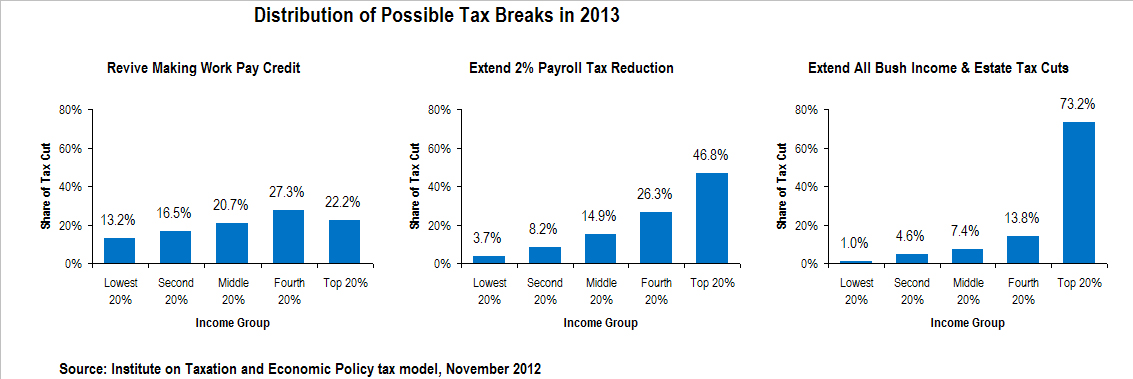In a 60 Minutes interview after his 2011 tax returns were released, Republican presidential candidate Mitt Romney was asked if his federal income tax rate was fair.
CBS’s Scott Pelley: And you paid 14 percent in federal taxes. That’s the capital gains rate. Is that fair to the guy who makes $50,000 and paid a higher rate than you did?
Romney: It is a low rate. And one of the reasons why the capital gains tax rate is lower is because capital has already been taxed once at the corporate level, as high as 35 percent.
Pelley: So you think it is fair?
Romney: Yeah, I think it’s the right way to encourage economic growth, to get people to invest, to start businesses, to put people to work.
Mitt Romney is wrong, and so is the tax system that he defends. His proposals would make it even worse.
In defending his tax rate, Romney is relying on the double taxation argument – that it’s fair to tax capital gain and dividend income at a much lower rate than other income, like salaries and wages, because it’s already been taxed once at the corporate level.
Here are three reasons why the double-taxation argument is unconvincing:
1) Much of the income qualifying for the low rate is not related to corporations
2) Even the income that is related to corporations may not have been previously taxed
3) Romney’s income in particular is not from corporate profits
For one thing, all kinds of income that didn’t come from corporations is taxed at the special low rate, such as profits from selling office buildings, corn futures and exotic sports cars. Romney’s own reported income is dominated by so-called capital gains that are really “carried interest” – compensation from managing Bain Capital, his leveraged-buyout firm, that he can restructure as investment income so it doesn’t get taxed like ordinary salary or wages. Romney also has millions in gains from hedge funds, bonds, and foreign corporations, none of which was subject to the U.S. corporate income tax.
Even when corporate dividends are paid to shareholders, it’s highly likely that the corporation hasn’t paid much tax on the income they use to cover those dividend payments. Take G.E., for example. Over the last decade the company has paid out $87 billion in dividends but paid an average federal income tax rate of just 1.8 percent.
Significantly, many of the companies managed by Romney’s Bain Capital aren’t paying income tax either. Sensata Technologies, for example, used to pay tax – before Bain loaded it up with debt and started moving its operations offshore. Now it doesn’t have any U.S. income to tax
But wait, defenders of low- or no-capital gains taxes say – the money Romney earned to make those investments was taxed when he earned it, and then the government taxes it again when the investments go up in value. Not true! Only the appreciation in the investments is taxed when you sell. The original investment isn’t taxed again.
When all is said and done, the low capital gains tax rate is a windfall for the wealthy. In 2013, it’s estimated that the share of capital gains going to the top five percent will be 83 percent. This low tax rate on capital gains and dividends is also the reason that Warren Buffett pays a lower tax rate than his secretary and that Mitt Romney pays a lower rate than the middle-income worker 60 Minutes asked him about.
 Whether you make $60,000 or $60 million, if your income is from work you’ll pay more than twice as much federal income tax than someone whose income is from wealth, and you’ll pay payroll taxes on top of that. Romney’s tax plan would make it even worse because he’s proposing to completely exempt up to $200,000 of interest, dividends, and capital gains from income taxes.
Whether you make $60,000 or $60 million, if your income is from work you’ll pay more than twice as much federal income tax than someone whose income is from wealth, and you’ll pay payroll taxes on top of that. Romney’s tax plan would make it even worse because he’s proposing to completely exempt up to $200,000 of interest, dividends, and capital gains from income taxes.
Now, this might sound great to a lot of middle-income Americans who have a little bit of investment income – saving the tax on their interest from the bank or on dividends from that mutual fund. But consider this: under Romney’s plan, an heiress or day trader with $200,000 of investment income but no salary or business income would pay zero federal income tax, while working Americans with that much income would pay plenty of tax on their salaries and wages.
Getting rid of the unwarranted tax breaks for wealthy investors and treating working taxpayers more fairly should be at the heart of real tax reform. But real tax reform is just the opposite of what Mitt Romney has in mind.
![]()





 Local governments in Ohio have taken tremendous fiscal hits in recent years and now many are resorting to the ballot box to close their budget gaps. Next week Ohio voters will be voting on
Local governments in Ohio have taken tremendous fiscal hits in recent years and now many are resorting to the ballot box to close their budget gaps. Next week Ohio voters will be voting on  Whether you make $60,000 or $60 million, if your income is from work you’ll pay more than twice as much federal income tax than someone whose income is from wealth, and you’ll pay payroll taxes on top of that. Romney’s
Whether you make $60,000 or $60 million, if your income is from work you’ll pay more than twice as much federal income tax than someone whose income is from wealth, and you’ll pay payroll taxes on top of that. Romney’s